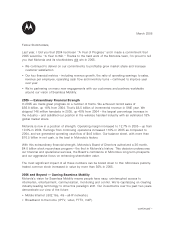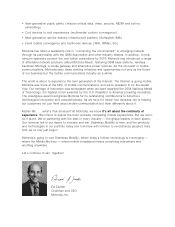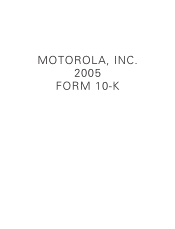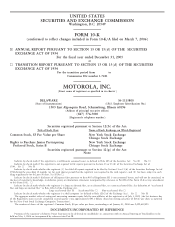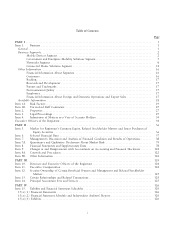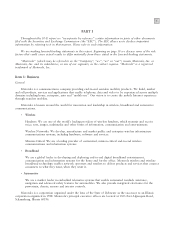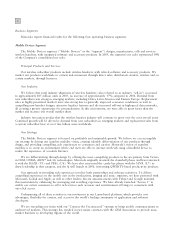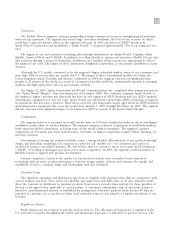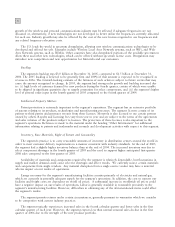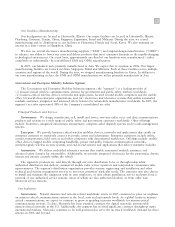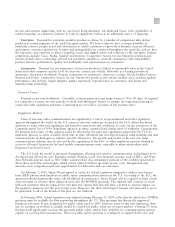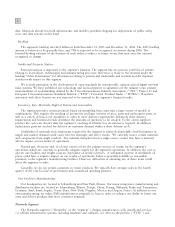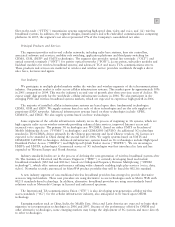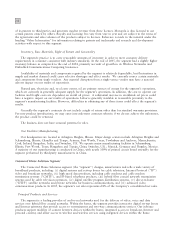Motorola 2005 Annual Report Download - page 9
Download and view the complete annual report
Please find page 9 of the 2005 Motorola annual report below. You can navigate through the pages in the report by either clicking on the pages listed below, or by using the keyword search tool below to find specific information within the annual report.
2
Business Segments
Motorola reports financial results for the following four operating business segments:
Mobile Devices Segment
The Mobile Devices segment (""Mobile Devices'' or the ""segment'') designs, manufactures, sells and services
wireless handsets, with integrated software and accessory products. In 2005, the segment's net sales represented 58%
of the Company's consolidated net sales.
Principal Products and Services
Our wireless subscriber products include wireless handsets, with related software and accessory products. We
market our products worldwide to carriers and consumers through direct sales, distributors, dealers, retailers and, in
certain markets, through licensees.
Our Industry
We believe that total industry shipments of wireless handsets (also referred to as industry ""sell-in'') increased
to approximately 815 million units in 2005, an increase of approximately 17% compared to 2004. Demand from
new subscribers was strong in emerging markets, including China, Latin America and Eastern Europe. Replacement
sales in highly-penetrated markets were also strong due to generally improved economic conditions, as well as
compelling new handset designs, attractive handset features and the increased roll-out in high-speed data networks,
all creating a greater opportunity for personalization. In this environment, we were able to grow faster than the
market and increase our overall market share.
Industry forecasters predict that the wireless handset industry will continue to grow over the next several years.
Continued growth will be driven by demand from new subscribers in emerging markets and replacement sales from
a current subscriber base of over two billion users worldwide.
Our Strategy
The Mobile Devices segment is focused on profitable and sustainable growth. We believe we can accomplish
our strategy by driving our seamless mobility vision, creating valuable differentiation of our products through
design, and providing compelling, rich experiences to consumers and carriers. Motorola's vision of seamless
mobility is to create an environment where end users are able to interact wirelessly using a handheld device to
realize the experience of a mobile Internet.
We are differentiating through design by offering the most compelling products in the six primary form factors
in GSM, CDMA, iDEN» and 3G technologies. Motorola originally invented the clamshell phone and has reinvented
it with the RAZR (V3) and PEBL (U6). We have also reinvented the candy bar phone with the SLVR (L7) to
show leadership in that category, and the Q will launch in 2006, reinventing QWERTY-based productivity products.
Our approach to providing rich experiences involves both partnerships and in-house initiatives. To deliver
compelling experiences to the mobile user in the productivity, imaging and music segments, we have partnered with
Microsoft, Kodak and Apple, as well as other leaders. Recent announcements with Yahoo! and Google maintain
this momentum by enhancing the messaging and searching experience. We have already launched ""Screen 3'' to
enable our carrier customers to offer rich services such as music and entertainment offerings to consumers with
one-click access.
Underpinning all of these activities is our investment in our Linux-based platform, which provides cost
advantages, flexibility for carriers, and access to the world's leading community of application and software
developers.
We are extending our vision with our ""Connect the Unconnected'' strategy to bring mobile communications to
underserved markets. This strategy has resulted in two major contracts with the GSM Association to provide mass-
market handsets to developing regions of the world.



